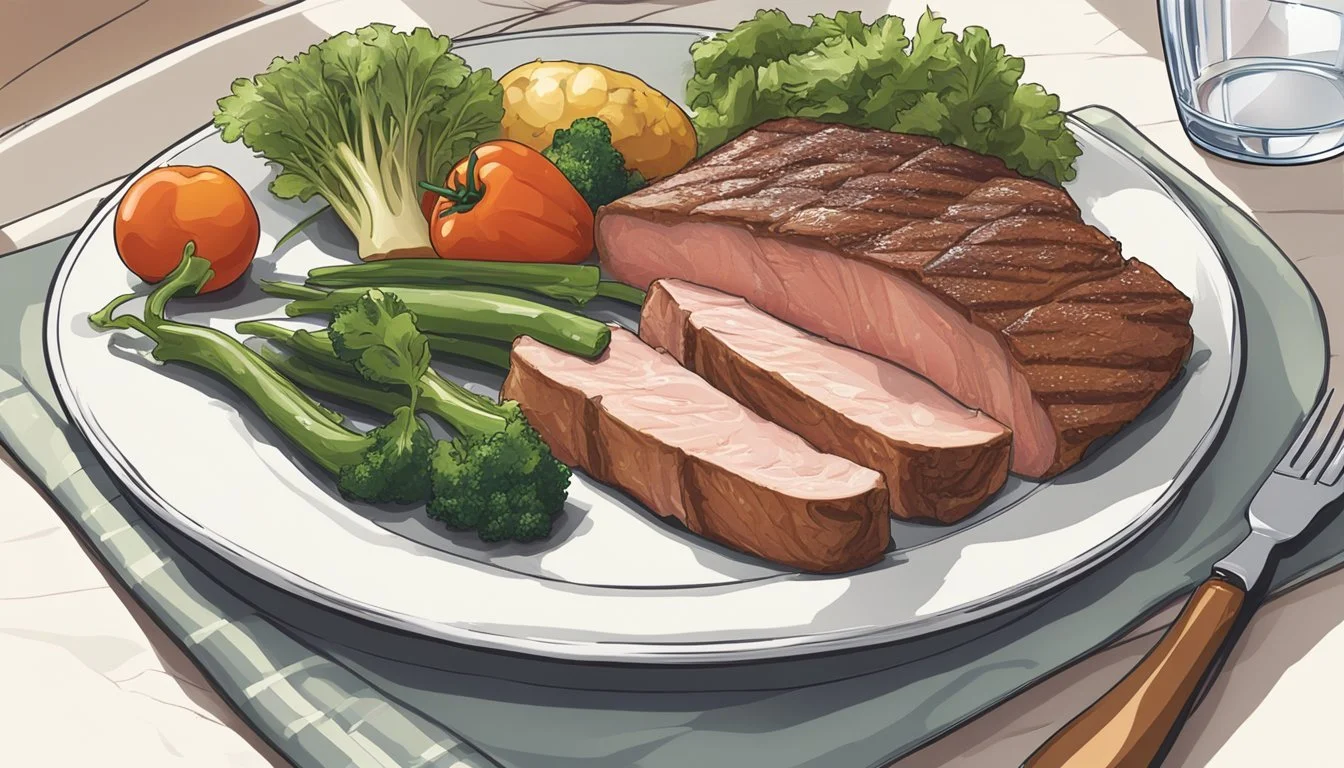Foods That Help Manage Acid Reflux Symptoms Naturally
Millions of people experience acid reflux, a condition where stomach acid backs up into the esophagus, leading to discomfort and heartburn. Diet plays a crucial role in managing and alleviating the symptoms of acid reflux.
Identifying and incorporating foods that help reduce acid reflux can significantly improve one’s quality of life. Understanding which foods to include and avoid can be key to mitigating the impact of this common condition. Here, insights and practical advice are provided to help those suffering from acid reflux make informed dietary choices.
1) Ginger Tea
Ginger tea is regularly recommended for those experiencing acid reflux or GERD. It is known for its anti-inflammatory properties, which can help soothe the stomach and reduce symptoms related to acid reflux.
To make ginger tea, fresh ginger slices are commonly boiled in water for about 10 minutes.
Honey or lemon can be added for additional flavor, providing a slight sweetness or a citrusy kick. Both ingredients may also offer their own health benefits. It is advisable to consume ginger tea while it’s still warm for the best effect.
However, it’s important to note that consuming more than 6 grams of ginger per day could possibly worsen reflux symptoms. Moderation is key when incorporating ginger tea into your diet.
Ginger is available in various forms such as capsules, powder, and oil, which can also be used to make tea. Remember to consult with a healthcare professional if you’re unsure about the appropriate dosage.
2) Aloe Vera Juice
Aloe vera juice is known for its soothing properties, which can be beneficial for those suffering from acid reflux. This natural remedy helps calm inflammation in the lining of the digestive tract, reducing symptoms of acid reflux.
To maximize its benefits, it is essential to use pure, high-quality aloe vera juice. Consuming aloe vera juice regularly can aid digestion and alleviate discomfort associated with acid reflux.
A safe starting amount is around 10 ml (2 tsp) of aloe vera juice daily, preferably taken 20 minutes before a meal. It's important to avoid products with added sugars or artificial ingredients.
Mixing aloe vera juice with other mild ingredients such as cucumber, spinach, and celery can make it more palatable. Remember to always consult with a healthcare provider before starting any new health regimen.
3) Bananas
Bananas are often recommended for those suffering from acid reflux.
Their low acidity helps neutralize stomach acid, reducing discomfort. Bananas are fiber-rich, promoting smoother digestion.
The potassium in bananas also helps maintain normal digestive tract function.
Bananas are convenient, easy to incorporate into any diet, and can be eaten alone or added to smoothies and cereals.
4) Oatmeal
Oatmeal is a beneficial food choice for individuals dealing with acid reflux. This fiber-rich breakfast option can help absorb stomach acid and stabilize digestive processes.
Its texture may also aid in coating the esophagus, reducing irritation.
Oatmeal does not trigger reflux symptoms in most people, making it a safe option.
In addition to being non-irritating, oatmeal is versatile. It can be paired with non-citrus fruits like bananas and apples, both of which are easier on the stomach.
These combinations can enhance the ease of digestion while offering essential nutrients.
Choosing plain or minimally sweetened oatmeal is advisable to avoid added sugars that could potentially worsen reflux.
Incorporating oatmeal into a daily diet can provide a comforting and nutritious start to the day without exacerbating acid reflux symptoms.
5) Green Leafy Vegetables
Green leafy vegetables are among the top choices for those dealing with acid reflux. Vegetables such as spinach, kale, and Swiss chard are naturally low in acid. Their low pH levels can help balance the high pH levels found in stomach acids.
In addition to their alkaline nature, green leafy vegetables are packed with essential nutrients. They provide vitamins and minerals that support overall digestive health. Their high fiber content also aids in digestion, promoting regular bowel movements and reducing the likelihood of acid reflux.
Consuming these vegetables can be simple. They can be added to salads, smoothies, or lightly steamed as a side dish. The versatility of green leafy vegetables makes them easy to incorporate into a daily diet, helping to manage acid reflux more effectively.
Moreover, these vegetables have anti-inflammatory properties which further assist in calming the digestive tract. Regular consumption can lead to a noticeable reduction in acid reflux symptoms.
Including a variety of green leafy vegetables in meals not only supports acid reflux management but also contributes to overall health and well-being. They are a practical and beneficial addition to anyone's diet.
6) Lean Meats
Lean meats are a beneficial choice for individuals managing acid reflux. These meats include options like skinless chicken and turkey breast. They have lower fat content, which makes them easier to digest compared to fatty meats.
This reduced fat content means lean meats are less likely to sit in the stomach for an extended period. This can help to minimize the risk of acid reflux symptoms. When choosing lean meats, it’s important to avoid adding high-fat ingredients during preparation.
Another good option is lean beef. Examples of lean beef cuts are sirloin or tenderloin. These cuts have less fat which can help prevent reflux symptoms. Seafood also falls into the category of lean meats and offers similar benefits.
Incorporating lean meats into meals can provide a good source of protein without aggravating acid reflux. It's advisable to grill, bake, or broil these meats instead of frying them. This way, one can enjoy a nutritious and reflux-friendly meal.
7) Non-Citrus Fruits
Non-citrus fruits are a key component for individuals looking to manage acid reflux. These fruits have a higher pH compared to citrus fruits, making them less likely to trigger symptoms.
Bananas are a popular choice. They are low in acidity and can help coat the stomach lining. This provides a soothing effect for those with reflux.
Melons, such as cantaloupe and watermelon, are also beneficial. They have a high water content, which can help dilute stomach acid. This makes them less irritating to the esophagus.
Apples and pears are other excellent options. They are rich in fiber, which aids digestion. Their low acidity makes them gentle on the stomach.
Grapes and cranberries are additional non-citrus fruits that can be included in the diet. These fruits offer various nutrients while being less likely to provoke reflux compared to their citrus counterparts.
Incorporating a variety of these non-citrus fruits into daily meals can provide essential vitamins and help minimize acid reflux episodes. It is advisable to enjoy these fruits in moderation and as part of a balanced diet.
8) Brown Rice
Brown rice is a whole grain that retains its nutrient-rich bran and germ layers. This makes it an excellent choice for people with acid reflux.
Whole grains like brown rice are high in fiber, which can help regulate digestion and prevent the stomach from producing excess acid.
Its complex carbohydrates are digested more slowly, providing a steady source of energy without triggering reflux symptoms.
Due to its lower acidity, brown rice is a safer option compared to more acidic foods.
Incorporating brown rice into meals can be both nutritious and supportive for managing acid reflux symptoms.
9) Melons
Melons are highly recommended for those dealing with acid reflux. Their high water content helps to dilute stomach acid, reducing irritation in the esophagus.
Watermelons are particularly beneficial. With 92% water, they can soothe the digestive tract. This fruit also contains antioxidants and anti-inflammatory properties that may support overall digestive health.
Cantaloupe and honeydew are also excellent choices. They are mildly alkaline, which helps to neutralize stomach acid. This reduces the likelihood of reflux occurring.
These fruits are generally well tolerated. They provide essential vitamins and minerals including vitamin C, potassium, and fiber, making them nutritious as well as helpful for managing symptoms.
Incorporating melons into the diet can be as simple as eating them fresh, adding them to salads, or blending them into smoothies. This adds both variety and a range of health benefits to meals.
10) Potatoes
Potatoes, especially in their boiled or baked forms, can be a beneficial addition to a diet aimed at reducing acid reflux symptoms.
Rich in complex carbohydrates, potatoes help in absorbing excess stomach acid, providing a soothing effect on the digestive system.
Sweet potatoes are another good option, as they are packed with nutrients and have anti-inflammatory properties.
It is important to avoid fried or heavily seasoned potatoes, as these can aggravate reflux symptoms.
Sticking to simple preparations ensures that the potatoes retain their beneficial qualities without triggering discomfort.
For those with acid reflux, choosing potatoes as a staple can contribute to a balanced, reflux-friendly diet.
Understanding Acid Reflux
Acid reflux occurs when stomach acid backs up into the esophagus, leading to discomfort and potential long-term damage. Knowing the causes, symptoms, and diagnosis methods can help in effectively managing this condition.
Causes of Acid Reflux
Acid reflux is often caused by the malfunctioning of the lower esophageal sphincter (LES). The LES is a ring of muscle that opens to let food into the stomach and then closes to prevent acid from escaping. When it weakens or relaxes improperly, acid can flow back into the esophagus.
Common triggers include certain foods and beverages, such as spicy foods, citrus fruits, alcohol, and caffeine. Obesity, pregnancy, and smoking are also contributing factors. Additionally, hiatal hernia, a condition where part of the stomach pushes through the diaphragm, can lead to reflux.
Symptoms of Acid Reflux
Typical symptoms of acid reflux include heartburn, a burning sensation in the chest or throat, and regurgitation, where stomach contents come back up into the throat or mouth. These symptoms often occur after eating and may worsen when lying down or bending over.
Other symptoms include difficulty swallowing (dysphagia), chronic cough, sore throat, hoarseness, and a feeling of a lump in the throat. Persistent acid reflux can lead to more serious conditions, such as esophagitis, Barrett's esophagus, and even esophageal cancer.
Diagnosis and Treatment
Diagnosing acid reflux typically involves a review of symptoms and medical history. Doctors may perform tests like endoscopy, where a flexible tube with a camera is inserted into the esophagus to look for damage. Esophageal pH monitoring measures acid levels, while barium swallow radiographs can visualize abnormalities.
Treatment options focus on lifestyle changes and medications. Patients are often advised to avoid trigger foods, eat smaller meals, and maintain a healthy weight. Over-the-counter antacids, H2 receptor blockers, and proton pump inhibitors can reduce acid production. In severe cases, surgery may be considered to strengthen the LES.
Dietary Modifications to Manage Reflux
Adjusting your diet can significantly help in managing acid reflux. Key changes include avoiding trigger foods, incorporating beneficial foods, and considering meal timing and portion sizes.
Foods to Avoid
Certain foods are known to exacerbate acid reflux symptoms. Fatty foods, like fried items and fast food, can relax the lower esophageal sphincter, allowing stomach acid to flow back into the esophagus. Spicy foods, such as chili peppers, often irritate the digestive tract.
Acidic foods, including citrus fruits and tomatoes, may increase stomach acidity, triggering symptoms. Additionally, beverages like coffee, tea, and alcohol can cause reflux by relaxing the esophageal sphincter or increasing acid production. Mint and peppermint are also known to cause similar issues.
Beneficial Foods for Acid Reflux
Certain foods can help alleviate symptoms of acid reflux. Vegetables, such as broccoli, green beans, and cucumbers, are low in acid and fat, making them ideal. Lean meats, including chicken and turkey, are better alternatives to fatty cuts of meat.
Complex carbohydrates, like oatmeal and whole grains, can absorb stomach acid and reduce symptoms. Healthy fats, such as those found in avocados, nuts, and seeds, are preferable to the saturated fats found in fried foods. Incorporating these foods can make a noticeable difference in symptom relief.
Meal Timing and Portions
Eating habits dramatically affect acid reflux management. Smaller, more frequent meals prevent excess stomach pressure and reduce the likelihood of acid flow back into the esophagus. Large meals can expand the stomach and push acid upward.
It is also crucial to avoid lying down immediately after eating, as this position can promote reflux. Waiting at least 2-3 hours after a meal before going to bed or reclining can help. Elevating the head of the bed by 6-8 inches can further aid in reducing nighttime reflux.
By making these dietary modifications, individuals can better manage their reflux symptoms and improve their quality of life.
Lifestyle Changes for Reflux Relief
Specific lifestyle adjustments can significantly reduce acid reflux symptoms. Focusing on maintaining a healthy weight, adopting better sleeping positions, and avoiding certain behaviors that trigger reflux are crucial steps.
Maintaining a Healthy Weight
Excess weight can put pressure on the abdomen, causing stomach acid to move into the esophagus. Reducing weight through a balanced diet and regular exercise can alleviate this pressure. He or she should aim for gradual, sustainable weight loss by consuming nutrient-rich foods and avoiding high-fat, high-sugar items. Even a modest reduction in weight can lead to a noticeable improvement in reflux symptoms.
Sleeping Positions and Habits
How you sleep can impact the severity of acid reflux. Elevating the head of the bed by about 6-8 inches ensures that stomach acid stays where it belongs. Using a wedge-shaped pillow can achieve this incline. Additionally, sleeping on the left side is recommended, as it reduces the likelihood of acid backing up into the esophagus. Avoid lying down immediately after eating, and allow 2-3 hours post-meal before heading to bed.
Avoiding Trigger Behaviors
Certain behaviors exacerbate reflux symptoms and should be avoided. Smoking relaxes the lower esophageal sphincter, making it easier for stomach acid to escape. Alcohol can have a similar effect, and both should be minimized if not eliminated. Eating large meals stretches the stomach and can force acid upwards, so smaller, more frequent meals are advised. Tight clothing that constricts the abdomen should also be avoided as it can increase abdominal pressure and cause reflux.





